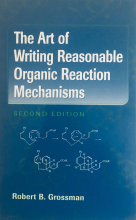The Art of Writing Reasonable Organic Reaction Mechanisms

Book summary:
Intended for students of intermediate organic chemistry, this text shows how to write a reasonable mechanism for an organic chemical transformation. The discussion is organized by types of mechanisms and the conditions under which the reaction is executed, rather than by the overall reaction as is the case in most textbooks. The treatment emphasizes unifying principles, showing how common mechanisms link seemingly disparate reactions. Each chapter discusses common mechanistic pathways and suggests practical tips for drawing them. Worked problems are included in the discussion of each mechanism, and “common error alerts” are scattered throughout the text to warn readers about pitfalls and misconceptions that bedevil students. Each chapter is capped by a large problem set. The author has drawn on his own research and the current literature to ensure that appropriate attention is given to topics across the range of modern organic chemistry. The text is unique in its inclusion of a chapter on reactions mediated or catalyzed by transition metals, an area in which mechanistic understanding is now essential. Relatively new topics such as olefin metathesis and cycloaromatization are covered without giving short shrift to more traditional areas such as carbonyl chemistry. The text assumes a basic knowledge of organic chemistry. It can be used either in a formal course or by students working on their own, and will be particularly useful for graduate students studying for qualifying examinations. It will also be useful to students and researchers in biochemistry, pharmacology, and inorganic chemistry.
Praise:
Quote:
The Art of Writing Reasonable Organic Reaction Mechanisms has an entirely different scope, dedicated to teaching the application of first principles to the construction of organic mechanisms. … The number of problems incorporated into the text is extraordinary. The author provides the student a Web site that includes the detailed mechanisms for every problem in the book … . The writing is clear, concise, engaging and, at times, outright entertaining. … All sections are expertly written, well organized and up-to-date.
Credit:
R. W. Holman, Journal of Chemical Education, Vol. 80 (11), 2003
Quote:
In principle, most mechanisms are derived from a basis set of fundamental steps. … Grossman has succeeded in explaining these fundamentals in detail in an easily accessible monograph. … Readers can reinforce their incipient skills with practical illustrations, and are challenged throughout with complicated examples. … the present text offers additional lucid explanations and ideal opportunities for practice. This work will thus be indispensable for students who are interested in mechanisms, or who wish to gain an additional perspective.
Credit:
www.organische-chemie.ch, July, 2004
Quote:
Robert Grossman in his book attempts to familiarize the student with the awesome power of reaction mechanisms … . What makes this book special and praise-worthy is the clarity of its presentation of the subject matter. The text is lucid and sharp-edged throughout. The production quality of the book is first-class, too. Paper, printing and binding are excellent, the reproduction of the numerous formulae and reaction schemes is outstanding. … Full marks for this ‘survival guide’ to the ‘organic jungle’.
Credit:
T. Lazar, Synthesis, Issue 17, 2003
Quote:
Robert Grossman discusses ideas on organic chemical reactivity, selectivity and structure in a logical way that gives the student confidence in attempting the many practice problems provided. … This book provides a snapshot of examples of how to consider and approach the writing of simple and sophisticated examples of pushing electrons in and out of orbitals. Students will enormously benefit from using the principles and concepts in this book in writing their own mechanisms.
Credit:
Helmut Hügel, Chemistry in Australia, 2003
Quote:
I have just finished my first year of graduate studies in organic chemistry at Duke University. I just wanted to let you know how much your book got me through the past year of course work. We, like everyone else, use Carey and Sundberg for our advanced organic classes. I personally do not care much for those books and therefore seek better explanation/understanding through other texts such as Lowry an Richardson and Carrol. When it came to mechanisms, I found the clarity and thoroughness I needed only in your book. It was impressive how you were able to present so much information in a clear and comprehensive manner yet keep the book so managable [sic] in size.
In addition to the text, I also was able to benefit from the problems. I was sure I had the answer for more than a couple but I was way off on some of them! Great practice!! The on-line answers are much better than looking up answers by reference as in Carey and Sundberg. The JOC and JACS journals in our library from 1960s-1980s are a wreck because every year 20 or so first year grad students go tearing off through the journals looking up answers.
Just wanted to say thanks for such a helpful book. I am reading it again this summer in preparation for my preliminary exam next Spring.
Credit:
David Gooden, personal communication
Quote:
I am David Peralta, a Master's student and lecturer at the Department of Chemistry in the Ateneo de Manila University in the Philippines. I am writing in admiration (and gratitude) for your book, "The Art of Writing Reasonable Organic Reaction Mechanisms" (2nd Ed.). You see, I have just finished taking my Organic comprehensive exam last Tuesday and (even though I still had a difficult time with the exam) I am ecstatic that I passed. As I have always considered organic mechanisms my Waterloo in Org-Chem, I have found your book and methods of great help. The explanations were very clear and all ideas were excellently presented. The excercises [sic] with the online answers were helpful in preparing too. I'd gladly recommend the book to anyone preparing for similar exams or even those who just want to brush up on mechanisms.
Again, thanks for the great book. A lot of chemistry students (undergraduate and graduate) at our University are already finding your book really helpful.
Credit:
David Peralta, personal communication
Quote:
I bought this book to practice mechanisms because I'll be taking a physical organic class in the spring that uses them heavily. I used this book instead of sitting in on a sophomore organic class, because by job as a TA conflicted.
Anyway, this book is extraordinary. Dr. Grossman has taught me so many things about how to write a correct mechanism and how to recognize a bad mechanism when I see one. The book is written in a very clear and friendly manner and it's really quite hard to put down when you start reading it.
The book also has practice problems and the book's website has the answers, giving even more incentive to practice mechanisms.
Credit:
Jason B., Amazon.com
Quote:
Wow. I have been searching for a book like this since my undergrad days at the University of Pittsburgh. Not much more to say about this book than has already been said. I will however say that this is the most concise book that I have ever found on the theory of mechanisms. It is decievingly short, for it encompases all the major topics you will find in your 1200 page O-chem text, and dare I say, may be just as, if not more usefull.
In organic chemistry it is not important to memorize a vast amount of material as, incorrectly, most neophyte students believe. The science really is an art with a few major rules that outline the whole of the science. If you truly UNDERSTAND these rules, and use this book for that purpose, you will succeed at any Organic course any school has to offer. Buy this book. Practice your problems. Be prepared to learn, not memorize.
Credit:
Michael Cook, Amazon.com
Bio:
Short bio:
Robert B. Grossman earned his A.B. at Princeton University, where he carried out research under the direction of Robert A. Pascal. After graduating in 1987, he moved to MIT and worked under the direction of Stephen L. Buchwald to develop zirconium- and titanium-mediated and -catalyzed organic synthetic methodology. He earned his Ph.D. in 1992 and moved from Steve’s lab in Cambridge to Steve’s lab in Cambridge, England, where he worked in the Ley group on various aspects of the chemistry of azadirachtin. In 1994 he left the UK to join the faculty at UK. His research interests are the development of new synthetic methodology and the study of biosynthetic pathways.
A&S department affiliation:
Book URL:
http://www.uky.edu/~rbgros1/textbook.html


